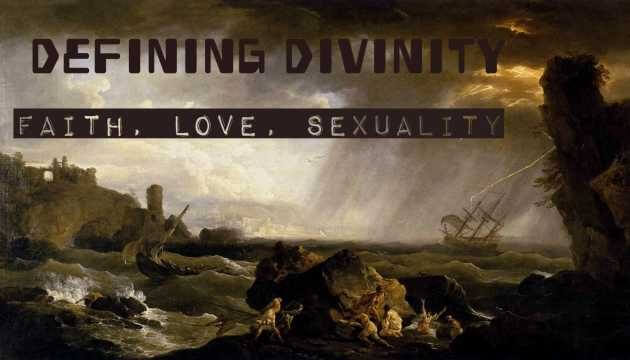To Dionese…
The Earth rouses herself from her winter gloom. The sun rays shine with rising vigour on the fast melting snow. Trees begin to sprout new shoots. Bees and butterflies hover over blooming rainbows. Animals shake off their drowsy hibernation to welcome the renewal of spring. The whole of Nature participates in a conspiracy of procreation.
And the race of man engages in masquerades of religion…
Scene 1. Michigan.
 A man holds a knife and a woman holds a chalice. Having invoked the goddess, the man plunges the knife into a chalice filled with milk and honey; enacting through symbols, the Great Rite of Ishtaar or Ostara, the sexual union of the ancient Goddess of fertility with Pan, the god of Nature.
A man holds a knife and a woman holds a chalice. Having invoked the goddess, the man plunges the knife into a chalice filled with milk and honey; enacting through symbols, the Great Rite of Ishtaar or Ostara, the sexual union of the ancient Goddess of fertility with Pan, the god of Nature.
The history of the festival dates back to prehistoric Mesopotamia when the New Year was celebrated at the time of the spring equinox through sensuous rituals evoking the fertility goddess Ostara (the eastern star) associated with the fecund symbols of the hare and egg.
 Scene 2.Ancient Babylonia.
Scene 2.Ancient Babylonia.
The King approaches the divine abode of Inana with sensuous offerings while the crowds throng around the temple grounds chanting sacred erotic poems. The High Priestess of Ashtoreth awaits her royal seeker: “When for the wild bull, for the lord, I shall have bathed, when for the shepherd Dumuzi, I shall have bathed . . . When with amber my mouth I shall have coated, when with kohl my eyes I shall have painted.” In their union they re-enact the pulsating vibrating communion of Thammuz (Dumuzi) with his consort Astarte, the horned moon goddess.
Scene3. Ancient Rome.
A pai r of Luperci , the priests of the fertility god Lupercus, dressed only in a goatskin, cut thongs from the skins of the sacrificial animals, which were called februa, and ran in two bands around the Palatine hill, striking with the thongs at women lined up on their route to receive lashes from these whips. They bare their flesh praying to be whipped, as this ‘ritual whipping’ was believed to bring fertility and ease the pain of childbirth.
r of Luperci , the priests of the fertility god Lupercus, dressed only in a goatskin, cut thongs from the skins of the sacrificial animals, which were called februa, and ran in two bands around the Palatine hill, striking with the thongs at women lined up on their route to receive lashes from these whips. They bare their flesh praying to be whipped, as this ‘ritual whipping’ was believed to bring fertility and ease the pain of childbirth.
Scene 4. Beijing.
A young woman arranges the stalks of nectarines and oranges with an assortment of seeds.
The new year brings a new hope of renewal throughout the massive landscape of China. Stalked nectarines and seeds act as potent symbols of fertile plenitude which counter barrenness.
Scene 5. Okayama, Japan.
A lucky man in loincloth holds the talismanic shingi, sacred stick measuring 4 cm in diameter and 20 cm in length, thrown into the crowd by the priest from a window 4 m up, and thrusts them upright in a wooden measuring box known as a masu which is heaped with rice.
Scene 6. Komaki, 45 minutes from the central city of Nagoya,Japan.
The old and young alike assemble at the shrine devoted to the phallus, to see an enormous wooden phallus carried  through the streets. It is the Honen-sai festival. Twenty four hours prior to this, In a neighboring village, a vagina festival is held. In Hime-no-miya grand vagina festival, at the Ogata shrine some 40 grown men strain under the weight of a massive vagina while carrying it to the shrine in the main parade. They’re followed by two smaller vagina litters. The 1500 year old twin festivals of Honen-sai and Hime-no-miya is rooted, in an ancient Japanese belief that for the growth and development of all things, the mother, earth, has to be impregnated by the father, heaven.
through the streets. It is the Honen-sai festival. Twenty four hours prior to this, In a neighboring village, a vagina festival is held. In Hime-no-miya grand vagina festival, at the Ogata shrine some 40 grown men strain under the weight of a massive vagina while carrying it to the shrine in the main parade. They’re followed by two smaller vagina litters. The 1500 year old twin festivals of Honen-sai and Hime-no-miya is rooted, in an ancient Japanese belief that for the growth and development of all things, the mother, earth, has to be impregnated by the father, heaven.
In short, human beings respond to the first rush of spring, translating desire into rituals of fertility.
Then why don’t we recognize the scenes as conforming to each other, as part of a divine fraternity.
There is only one plausible explanation so far.
We are made to believe that sexuality is a taboo and that any communal celebration of sexual union is sinful orgy.
We are made to believe that the human body is something to be ashamed of, that the human body is a burden, a site of sinful desires or a superficial garment of some abstraction called “soul”.
Our Grand Teachers are the high priests of monotheistic religions; Christianity, Judaism, Islam, Budhhism, Jainism, Zoroastrianism and so on.
We have had innumerable debates on religion; debates and blood sheds and status updates and you tube videos. We have documented historicized, prioritized one religion over another. The extent of bloodshed and the expanse of discourse defined and redefined the list that popular online search engines provide when one simply inputs the word “religion”. Interestingly we hardly try to find out from where this word gets its present form? Etymological studies say that “religion” is derived from the Late Latin word diligere (love, hold dear; value), which in turn is derived from the Greek word legein, λέγω (to speak); and finally this is derived from the Proto-Indo-European root leig- (to collect,to gather, to speak).
Therefore, something that originally implied collective gathering of love has now become a word that implies exclusivist antagonism. What once united men has now become the mightiest weapon of anarchy.
However, deep down within the universal unconscious lies the primitive urges, to break the artificial codes imposed by the Grand Ringmasters. The Ringmasters interpret God as a singular entity who evokes more fear than love, and they hand out a code of denial, negation and abstinence (Thou Shall Nots) in the name of Holy Scriptures.
And every year spring returns to beckon the human kind to offer the only real thing they have to offer: their bodies. No matter what the names are, polytheistic religions are essentially pluralistic and pagan. They were the original rituals of the earth when she was rousing from her icy slumber, when the tectonic plates had not stabilized to fuse into continents after the Ice Age.
Bodies were not abodes of sin, but sacred temples. In Hinduism, religion is called “dharma”. It has, however, nothing to do with “divinity”. Dharma literally means “property” or “nature” of anything. So, religion was, during the ancient times, a path that conformed to human nature; not negating, but celebrating human instincts and impulses, including sexual desire. Fertility of the soil was considered as a reflection of fertility in man. Desire was not a sin, but a part of communal euphoria. Survival was the only “dharma”, and procreation was a necessary part of it. From a seasonal context, spring was the ideal season of mating for humans since that ensured childbirth during autumn, the season of plentiful harvest. It was not an isolated phenomena but spread throughout the world with rich variety.
With passage of time (thousands of years) versions of monotheism emerged which tabooed the communal evocation of fertility.
What is intriguing is that, despite the suffocating dictums of contemporary ecclesiastics, the undercurrents of popular rituals echo the primitive adoration of human body.
The Japanese celebrate nakedness in Matsuri, during springtime.
The lupercal priest whiplash barren skin of women. Lupercalia is held on 15th February(the month gets its name from the goatskin whips or Febra perhaps).
The Komaki festival is celebrated in March, and it is certainly an open adoration of human sexual selves.
The Dionysian Mysteries of pagan cults are believed to have consisted of two sets of rites: the secret rites of initiation and the public rites, or Dionysia. The public rites are believed to be the older of the two. In and classical Attica, the main festivities were held in the month of Elaphebolion (around the time of the spring equinox).

The ancient cults perform sacred (sexual) rites to pray to Astarte, the horned moon Goddess, who is also seen as Ashtaroth (the consort of Baal), Isis (soulmate of Osiris) or Istaara or Ostaara.
No matter what she was called in different regions, she was adored as the moon goddess divinely conjoined with Pan (or the God of Nature), also worshipped as Thammuz, Dumuzi, Baal, Bachhus and Dionysus.
(Dionysus is the god of wine, of ritual madness, fertility, theatre and religious ecstasy in Greek mythology.)
That includes the popular cults of Hinduism. If one feels appalled by the idea of Hinduism as something that promotes the idea of spring rituals venerating sexuality and fertility, they must never have encountered something like this:
 Shivratri, a prominent ritual of fertility is celebrated at the onset of spring, when the maidens lovingly drench the divine phallus in milk, offering the multi seeded “bael”( interestingly, also called the golden apple), a symbol of fertile fecundity.
Shivratri, a prominent ritual of fertility is celebrated at the onset of spring, when the maidens lovingly drench the divine phallus in milk, offering the multi seeded “bael”( interestingly, also called the golden apple), a symbol of fertile fecundity.
The world celebrates bareness,
To shed off
Barrenness.
For only when u shed off the garments,
The burdens of civilized rhetoric,
and become bare and naked,
can u shed off the barrenness,
And procreate.
“Oh, ye sentimental dissemblers, ye covetous ones! Ye lack innocence in your desire: and now do ye defame desiring on that account! Verily, not as creators, as procreators, or as jubilators do ye love the earth!”…
“Where is innocence? Where there is will to procreation. And he who seeketh to create beyond himself, hath for me the purest will.”
He gave us the code to break the mystery of religion. He gave us the awareness of Dionysus. Dionysus was “the affirmation of life, of force, of joy, in contrast to the image of the Crucified who represents the Christian ideal that is nothing but a negation of life, a curse on life.”
They are the blade and chalice in the six-pointed star of David and are found in the rituals of Ostara:
Speaking of symbols, the following one is associated instantly with a dominant monotheistic religion of contemporary world:

Ostara rites are celebrated throughout Christendom as the moment of rejuvenation, barely paying attention to the stealthy presence of such potent symbols from the past:
Dionysus (or Bacchus) is not the only deity who is associated simultaneously with wine, moon, theatre and religious ecstacy.
In fact he gets the best pictorial representation (not any secret symbolic one) in the most beloved image of divinity in India:
(Soma is a magical word which means both moon and wine. Lord Shiva holds the crescent moon on his head. He was the one to drink Halahal the counterpart of elixir or amrita, he is the God of the underworld, the Bhooteswar
Lord Shiva is represented as the frenzied dancer in ecstacy: as the Nataraj.

What if, there was no “They”Only He. Not two but one. What if, Bacchus was not a parallel god, but the Somnath whose legendary temple was broken again and again!
Human beings get driven by things they don’t fully comprehend. When they act with a conscious mind, knowing the options available to them, understanding the motivations behind every little choice they make, it is called an act of man.
On the other hand, when they participate together in any act, without comprehending the full implication of the actions, without understanding the instincts driving them from inside, to perform acts which have no logical assurance of reason, it is called religion.
We have had innumerable debates on religion; debates and blood sheds and status updates and you tube videos. We have documented, historicized, prioritized one religion over another. The extent of bloodshed and the expanse of discourse defined and redefined the list that popular online search engines provide when one simply types in the word “religion”.
It is time that we look around us and deep within us to realize the true worth of being human.
It is time we broke the tables
To build again.
And not just by greeting “Happy Valentine’s Day”, but by shedding off the outer garbs of pretense, falsehood and shame.
Let us celebrate Spring.
Let us celebrate the Dionysian;
And help Isis gather the scattered pieces of Osiris.
Happy Epiphany. Let the star be your guide!










